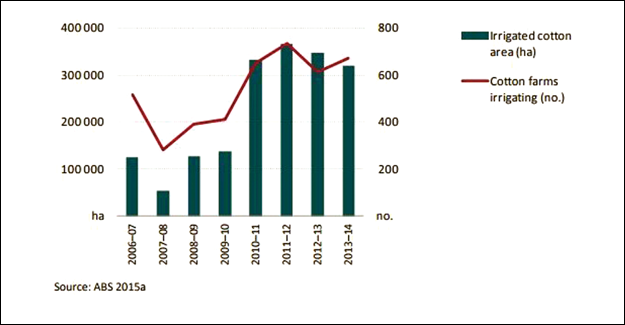Murray-Darling Basin Plan: How Much Water Is Used To Grow Cotton?
Murray-Darling Basin Plan: How Much Water Is Used To Grow Cotton?

Amid allegations that some cotton farmers have been tampering with water allocations earmarked for the environment in far west New South Wales (NSW), just how much water does it take to grow a crop?
Cotton's average irrigation requirement is 7.8 megalitres per hectare. This depends on the season's conditions. Cooler, milder summers, means crops might need less water, while prolonged days and nights of high temperatures means more irrigation is needed. Water use efficiency is something the industry, and the government, has been working on. Cotton growers almost doubled their irrigation water use efficiency from 1.1 bales/megalitre in 2000-01 to 1.9 bales/megalitre in 2009-10.
How does this compare to other irrigated crops?
Rice requires more water than cotton to produce a crop (12.6 megalitres per hectare), while fruit and nut trees are not as thirsty (requiring 5.6 megalitres per hectare), and cut flowers and turf use 4.9 megalitres per hectare. The largest area of irrigated land in Australia in 2013-14 was pasture and cereal crops used for grazing, which accounted for 30% of the total area irrigated. The largest volume of irrigation water was applied to cotton, which used 26% of the national irrigation total for the year, according to the Australian Bureau of Statistics. ABARES figures show irrigated cotton contributed an average of 20% of the total gross value of irrigated agricultural production.
Where is cotton grown?
According to the Australian Bureau of Agricultural and Resource Economics and Sciences around 90% of Australia's cotton is grown in the Murray-Darling Basin. The major production area in NSW includes the Gwydir, Namoi & Macquarie valleys. Cotton is also grown along the Barwon as well as Darling rivers in the west, besides the Lachlan and Murrumbidgee rivers in the south. Cotton has caused an economic renaissance in southern NSW, because people are planting it instead of rice. It's much more profitable, reliable, requires less water and producing it creates more jobs.
In Queensland, cotton is grown on the Darling Downs, in St George, Dirranbandi and Macintyre Valley regions and the remainder is grown near Emerald, Theodore and Biloela in central Queensland.
How much cotton is grown in Australia?
Again, this depends on seasonal conditions, prices and water availability. In the 2016/2017 season 470,000 hectares were planted, which produced 4.2-million bales. But this figure includes dryland cotton crops, which doesn't require irrigation. It's worth noting there was a large pull to the dryland crop, thanks to a wet winter boosting soil moisture profiles. In the previous 2015/2016 season 263,339 hectares were grown. In drought years like the 2007/2008 season only 68,585 hectares were planted producing 601,810 bales.
How many cotton farmers are there?
There are anywhere between 1,100 and 1,200 cotton farms in Australia. About half are in New South Wales and the other half in Queensland. But again this can change depending on seasonal conditions, access to water and prices.



 textileexcellence
textileexcellence 







